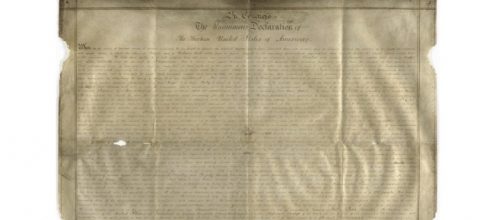An extremely rare copy of America's founding document, the Declaration of Independence, has been found. The only other known parchment copy of the document is in Washington, D.C. in The National Archives. There was the long-lost Native American city Etzanoa that got discovered in Kansas, as well.
The Declaration of Independence
A pair of researchers from the University of Harvard discovered the copy of the Declaration of Independence in southern England of all places. The copy was found at the West Sussex Records Office in Chichester. The document was listed in the records office online catalog.
The description only caught the attention of the Harvard pair because it said it was on parchment, as previous online descriptions have only led to 19th century reproductions of the document.
When they looked at photos of the document, the researchers noticed that details were off. The signers were not broken down by state, John Hancock's name was not first, and it was in different handwriting, among other things. They dated the copy to the 1780s, with it belonging to Charles Lennox, 3rd Duke of Richmond (1735-1806). He was known as the "Radical Duke" for his support of the colonists during the Revolutionary War (1775-83).
Etzanoa
Wichita State anthropologist and archaeologist Donald Blakeslee believes that he has discovered the long-lost Native American city of Etzanoa in Kansas.
It is the second largest known Native American settlement in the United States and was controlled by the Rayado (Wichita) Indians. The settlement was known through Spanish accounts, most notably as the location of a 1601 battle between the Spanish and Native Americans. However, it remained a mystery for the next 400 years, with some thinking its size of 20,000 was exaggerated.
This changed when Blakeslee discovered evidence of a town that had stretched across thousands of acres along the meeting point of the Walnut River and Arkansas River near modern-day Arkansas City. Then, a local high school student found a half-inch cannonball, just like what the Spanish would have used in the 1601 battle. Blakeslee then found a still-functional water shrine, which showed communication with the spirit world, carved into a limestone boulder in a backyard.
Residents of the town said that they have dug up Native American pottery and arrowheads for decades. Blakeslee also found evidence of the ravines, bluffs and rock-lined ravine that all matched up with the Spanish accounts of the city. Local town official are now hoping this discovery could bring economic prosperity from tourists, as the Cahokia Mounds Site does in western Illinois.

